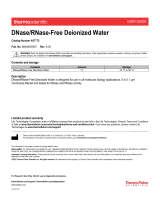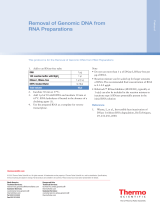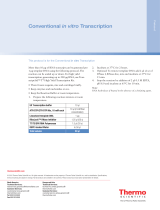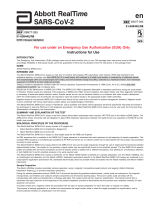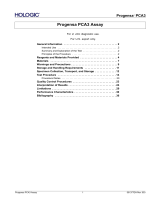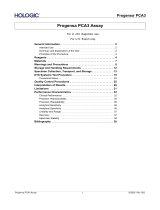Page is loading ...

Quant-iT™ RiboGreen™ RNA Reagent and Kit
Catalog Numbers R11490, R11491, T11493
Pub. No. MAN0002073 Rev. A.0
WARNING! Read the Safety Data Sheets (SDSs) and follow the handling instructions. Wear appropriate protective eyewear,
clothing, and gloves. Safety Data Sheets (SDSs) are available from thermofisher.com/support.
Product description
The Quant-iT™ RiboGreen™ RNA Reagent is an ultrasensitive fluorescent nucleic acid stain for quantitating RNA in solution. Detecting
and quantitating small amounts of RNA is important in many applications including measuring yields of in vitro transcribed RNA and
measuring RNA concentrations before performing Northern blot analysis, S1 nuclease assays, RNase protection assays, cDNA library
preparation, reverse transcription PCR, and dierential display PCR.
Figure 1 Dynamic range and sensitivity of the Quant-iT™ RiboGreen™ RNA Assay.
For the high-range assay (top panel), the Quant-iT™ RiboGreen™ RNA Reagent was diluted 200‑fold into 10 mM Tris-HCl, 1 mM EDTA, pH 7.5 (TE)
and 100 µL of the reagent solution was added to microplate wells containing 100 µL of ribosomal RNA in TE. For the low-range assay (bottom
panel), the Quant-iT™ RiboGreen™ RNA Reagent was diluted 2,000‑fold into TE and 100 µL of the reagent solution was added to microplate wells
containing 100 µL of ribosomal RNA in TE. Samples were excited at 485 ± 10 nm and the fluorescence emission intensity was measured at 530 ±
12.5 nm using a fluorescence microplate reader. Fluorescence emission intensity was then plotted versus RNA concentration.
The Quant-iT™ RiboGreen™ RNA Reagent enables quantitation of as little as 1 ng/mL RNA (200 pg RNA in a 200 µL assay volume) with a
fluorescence microplate reader using fluorescein excitation and emission wavelengths. The linear range of the Quant-iT™ RiboGreen™ RNA
USER GUIDE
For Research Use Only. Not for use in diagnostic procedures.

Reagent extends over three orders of magnitude in RNA concentration (1 ng/mL to 1 µg/mL) using two dye concentrations (Figure 1). The
high-range assay allows quantitation of 20 ng/mL to 1 µg/mL RNA, and the low-range assay allows quantitation of 1 ng/mL to 50 ng/mL
RNA. This linearity is maintained in the presence of several compounds commonly found to contaminate nucleic acid preparations,
including nucleotides, salts, urea, ethanol, chloroform, detergents, proteins, and agarose. Although the Quant-iT™ RiboGreen™ RNA
Reagent also binds to DNA, pretreatment of mixed samples with DNase can be used to generate an RNA-selective assay (see “Eliminate
DNA from samples” on page 5).
Contents and storage
Component
Quant-iT™ RiboGreen™
RNA Reagent[1]
Quant-iT™ RiboGreen™
RNA Assay Kit Concentration Storage[2]
Cat. No. R11491 Cat. No. R11490
Quant-iT™ RiboGreen™ RNA
Reagent (Component A)
1 mL 1 mL Solution in DMSO 2°C to 8°C[3]
Desiccate
Protect from light
20X TE Buer, RNase-free
(Component B)
Not applicable 25 mL 200 mM Tris-HCl, 20 mM
EDTA, pH 7.5 in DEPC-
treated water
≤30°C
Ribosomal RNA standard,
16S and 23S rRNA from
E. coli (Component C)
Not applicable 5 × 200 µL 100 µg/mL in TE buer 2°C to 8°C[4]
Avoid freeze-thaw cycles
Number of labelings: 2,000 to 20,000 with an assay volume of 200 µL in a 96-well microplate format. The Quant-iT™ RiboGreen™ RNA Assay can be
adapted for use in cuvettes or 384-well microplates.
Approximate fluorescence excitation/emission maxima: 500/525 nm, bound to nucleic acid.
[1] Stand-alone reagent does not include Components B and C.
[2] When stored as directed, products are stable for at least 6 months.
[3] For long-term storage, the Quant-iT™ RiboGreen™ RNA Reagent can be stored at ≤–20°C
[4] For long-term storage, store the rRNA standards at ≤–20°C or –70°C.
Required materials not supplied
• Nuclease-free pipettors and tips
• Nuclease-free water
• Microplates for Fluorescence-based Assays, 96-well (Cat. No. M33089)
Prepare the assay buer
Prepare the 1X TE working solution by diluting the concentrated buer (Component B) 20‑fold with nuclease-free water. Prepare nuclease-
free water by treating distilled, deionized water with 0.1% diethyl pyrocarbonate (DEPC), incubating for several hours at 37°C, and
autoclaving for at least 15 minutes at 15 lbs/sq. inch to sterilize the water and eliminate DEPC.
IMPORTANT! TE buer (10 mM Tris-HCl, 1 mM EDTA, pH 7.5) is used to prepare the Quant-iT™ RiboGreen™ RNA Reagent and for
diluting RNA standards and samples. Make sure the TE solution is free of contaminating nucleases and nucleic acids. The 20X TE buer
included in the Quant-iT™ RiboGreen™ RNA Assay Kit is nuclease-free and nucleic acid–free.
Prepare the reagent
Two dierent dye concentrations are required to achieve the full linear dynamic range of the Quant-iT™ RiboGreen™ RNA Assay. Before
preparing the working solution of the Quant-iT™ RiboGreen™ RNA Reagent, decide whether you wish to perform the high-range assay
(20 ng/mL to 1 µg/mL RNA), low-range assay (1 ng/mL to 50 ng/mL RNA), or both.
On the day of the experiment, allow the Quant-iT™ RiboGreen™ RNA Reagent to warm to room temperature before opening the vial,
then prepare an aqueous working solution of the Quant-iT™ RiboGreen™ RNA Reagent by diluting the concentrated DMSO stock solution
(Component A) into TE, 200‑fold for the high-range assay or 2,000‑fold for the low-range assay. For microplate assays of a total 200 µL
assay volume, you need 100 µL of the Quant-iT™ RiboGreen™ RNA Reagent working solution per sample.
For example, to prepare enough working solution to assay 100 samples in 200 µL volumes, add 50 µL Quant-iT™ RiboGreen™ RNA
Reagent to 9.95 mL TE for the high-range assay or add 5 µL Quant-iT™ RiboGreen™ RNA Reagent to 9.995 mL TE for the low-range
assay.
Note: Allow the Quant-iT™ RiboGreen™ RNA Reagent to warm to room temperature before opening the vial. Cold DMSO solutions absorb
moisture from warmer, room temperature air, resulting in loss of ecacy for the reagent. Always store the DMSO stock solution in the
2 Quant-iT™ RiboGreen™ RNA Reagent and Kit User Guide

presence of desiccant when not in use. We recommend preparing the working solution in sterile, disposable polypropylene plasticware
rather than glassware, as the reagent may adsorb to glass surfaces. Protect the working solution from light, as the Quant-iT™ RiboGreen™
RNA Reagent is susceptible to photodegradation. For best results, use the working solution within a few hours of preparation.
Prepare the RNA standard curve
1. Prepare a 2 µg/mL solution of RNA in TE using nuclease-free plasticware. Determine the RNA concentration on the basis of
absorbance at 260 nm (A260) in a cuvette with a 1 cm pathlength; an A260 of 0.05 corresponds to 2 µg/mL RNA.
The ribosomal RNA standard (Component C), provided at 100 µg/mL in the Quant-iT™ RiboGreen™ RNA Assay Kit, is diluted 50‑fold
in TE to make the 2 µg/mL working solution. For example, 4 µL of the RNA standard mixed with 196 µL of TE is sucient for the
standard curve described in step 2.
Note: For a standard curve, we commonly use 16S and 23S ribosomal RNA, although any purified RNA preparation may be used. It
is sometimes preferable to prepare the standard curve with RNA similar to the type being assayed. However, most single-stranded
RNA molecules yield approximately equivalent signals.
Note: The RNA solution used to prepare the standard curve should be treated the same way as the experimental samples and
should contain similar levels of contaminants. See “Eects of common contaminants” on page 4 for a list of contaminants tested
in the Quant-iT™ RiboGreen™ assay.
2. For the high-range standard curve, dilute the 2 µg/mL RNA solution into microplate wells as shown in Table 1. For the low-range
standard curve, dilute the 2 µg/mL RNA solution 20‑fold into TE to make a 100 ng/mL RNA stock solution, then prepare the dilution
series shown in Table 2.
Table 1 Protocol for preparing a high-range standard curve.
Volume of TE buer Volume of 2 µg/mL RNA stock
Volume of 200‑fold diluted
Quant-iT™ RiboGreen™ RNA
Reagent
Final RNA concentration in the
assay
0 µL 100 µL 100 µL 1 µg/mL
50 µL 50 µL 100 µL 500 ng/mL
90 µL 10 µL 100 µL 100 ng/mL
98 µL 2 µL 100 µL 20 ng/mL
100 µL 0 µL 100 µL blank
Table 2 Protocol for preparing a low-range standard curve.
Volume of TE buer Volume of 100 ng/mL RNA
stock
Volume of 2,000‑fold diluted
Quant-iT™ RiboGreen™ RNA
Reagent
Final RNA concentration in the
assay
0 µL 100 µL 100 µL 50 ng/mL
50 µL 50 µL 100 µL 25 ng/mL
90 µL 10 µL 100 µL 5 ng/mL
98 µL 2 µL 100 µL 1 ng/mL
100 µL 0 µL 100 µL blank
3. Add 100 µL of the appropriate aqueous working solution of Quant-iT™ RiboGreen™ RNA Reagent (prepared in “Prepare the reagent”
on page 2) to each microplate well. Use the high-range working solution for performing the high-range assay, and use the low-range
working solution for performing the low-range assay. Mix well and incubate for 2–5 minutes at room temperature, protected from
light.
4. Measure the sample fluorescence using a fluorescence microplate reader and standard fluorescein wavelengths (excitation
∼480 nm, emission ∼520 nm).
Note: To ensure that the sample readings remain in the detection range, set the instrument's gain so that the sample containing the
highest RNA concentration yields a fluorescence intensity near the microplate reader’s maximum. For optimal detection sensitivity,
the instrument gain can be increased for the low-range assay relative to the high-range assay. To minimize photobleaching eects,
keep the time for fluorescence measurement constant for all samples.
5. Subtract the fluorescence value of the reagent blank from that of each of the samples. Use corrected data to generate a standard
curve of fluorescence versus RNA concentration (see Figure 1).
Quant-iT™ RiboGreen™ RNA Reagent and Kit User Guide 3

Analyze samples
1. Dilute the experimental RNA solution in TE to a final volume of 100 μL in microplate wells.
Note: You can alter the amount of sample diluted, provided that the final volume remains 100 μL. High dilutions of the experimental
sample may serve to diminish the interfering eect of certain contaminants. However, extremely small sample volumes should be
avoided because they are dicult to pipet accurately. In addition, the level of assay contaminants should be kept as uniform as
possible throughout an experiment, to minimize sample-to-sample signal variation. For example, if a series of RNA samples contain
widely diering salt concentrations, then they cannot be compared to a single standard curve. To avoid this problem, simply adjust
the concentration of contaminants to be the same in all samples, if possible (see “Eects of common contaminants” on page 4).
2. Add 100 μL of the aqueous working solution of the Quant-iT™ RiboGreen™ RNA Reagent (prepared in “Prepare the reagent” on
page 2) to each sample. Incubate for 2–5 minutes at room temperature, protected from light.
3. Measure the fluorescence of the samples using the same instrument parameters used to generate the standard curve (see step 4).
To minimize photobleaching eects, keep the time for fluorescence measurement constant for all samples.
4. Subtract the fluorescence value of the reagent blank from that of each of the samples. Determine the RNA concentration of the
sample from the standard curve generated in “Prepare the RNA standard curve” on page 3.
5. The assay can be repeated using a dierent dilution of the sample to confirm the quantitation results.
Eects of common contaminants
The Quant-iT™RiboGreen™ Assay remains linear in the presence of several compounds that commonly contaminate nucleic acid
preparations, although the signal intensity may be aected (Table 3). For the highest accuracy, the standards should be prepared under
the same conditions as the experimental samples and contain similar levels of contaminants.
Table 3 Eects of common contaminants on the signal intensity of the assay.
Compound Maximum acceptable concentration % Signal change[1]
Salts
Ammonium acetate 20 mM 4% decrease
Sodium acetate 20 mM 11% decrease
Sodium chloride 20 mM 15% decrease
Zinc chloride 1 mM 9% decrease
Magnesium chloride 0.5 mM 9% decrease
Calcium chloride 0.1 mM 2% increase
Cesium chloride 10 mM 8% decrease
Guanidinium thiocyanate 10 mM 9% decrease
Urea 3 M 13% decrease
Organic solvents
Phenol 0.5% 5% decrease
Ethanol 20% 10% decrease
Chloroform 2% 15% increase
Detergents
Sodium dodecyl sulfate 0.05% 10% decrease
Triton™ X-100 0.5% 8% decrease
Proteins
Bovine serum albumin 0.2% 11% decrease
IgG 0.02% 4% decrease
4 Quant-iT™ RiboGreen™ RNA Reagent and Kit User Guide

Compound Maximum acceptable concentration % Signal change[1]
Other compounds
Formamide 10% 12% decrease
Sucrose >500 mM 4% decrease
Boric acid 100 mM 15% decrease
Polyethylene glycol 10% 10% decrease
Agarose 0.2% 3% increase
[1] The compounds were incubated at the indicated concentrations with the Quant-iT™ RiboGreen™ RNA Reagent in the presence of 1.0 mg/mL ribosomal RNA. All samples were
assayed in a final volume of 200 µL in 96‑well microplates using a fluorescence microplate reader. Samples were excited at 485 ± 10 nm and fluorescence intensity was measured
at 530 ± 12.5 nm.
Eliminate DNA from samples
The Quant-iT™ RiboGreen™ RNA Reagent also binds to DNA. Fluorescence in samples that is due to the Quant-iT™ RiboGreen™
RNA Reagent binding to DNA can be eliminated by pre-treating the sample with RNase-free DNase, ensuring that the entire sample
fluorescence is due to dye bound to RNA.
1. Prepare 10X DNase digestion buer: nuclease-free 200 mM Tris-HCl, pH 7.5, containing 100 mM MgCl2 and 20 mM CaCl2.
2. Add 0.11 volume of 10X DNase digestion buer to each DNA-containing sample (for example, to a 9 µL sample, add 1 µL 10X
buer).
3. Add ∼5 units of RNase-free DNase I per µg of DNA estimated to be in the sample.
4. Incubate the sample at 37°C for 90 minutes.
5. Dilute the sample at least 10‑fold into TE to diminish eects of the digestion buer salts on the Quant-iT™ RiboGreen™ assay
procedure.
6. Perform the Quant-iT™ RiboGreen™ assay as described (see “Analyze samples” on page 4).
Related products
Table 4 Bulk Reagents and Kits
Product Quantity Cat. No.
Quant-iT™ PicoGreen™ dsDNA Assay Kit 1 mL assay kit
10 x 100 µL
P7589
P11496
Quant-iT™ PicoGreen™ dsDNA Reagent 1 mL reagent
10 x 100 µL
P7581
P11495
TE Buer (20X), RNase-free 100 mL T11493
Quant-iT™ RiboGreen™ RNA Assay Kit 1 mL assay kit R11490
Quant-iT™ RiboGreen™ RNA Reagent 1 mL reagent R11491
Quant-iT™ RediPlate™ 96 RiboGreen™ RNA
Quantitation Kit 1 plate R32700
Quant-iT™ OliGreen™ ssDNA Assay Kit 1 mL assay kit O11492
Quant-iT™ OliGreen™ ssDNA Assay Reagent 1 mL reagent O7582
Quant-iT™ RiboGreen™ RNA Reagent and Kit User Guide 5

Table 5 Microplate Reader Assays
Product Dynamic Range Quantity Cat. No.
Quant-iT™ 1X dsDNA Assay Kit,
High Sensitivity 200 pg−100 ng 1,000 reactions Q33232
Quant-iT™ 1X dsDNA Assay Kit,
Broad-Range 4 ng−2 μg 1,000 reactions Q33267
Quant-iT™ DNA Assay Kit, High
Sensitivity 200 pg−100 ng 1,000 reactions Q33120
Quant-iT™ DNA Assay Kit, Broad-
Range 4 ng−1 μg 1,000 reactions Q33130
Quant-iT™ RNA Assay Kit 5−100 ng 1,000 reactions Q33140
Quant-iT™ RNA Reagent 5−100 ng 1,000 reactions Q32884
Quant-iT™ RNA Assay Kit, Broad
Range 20 ng−1 μg 1,000 reactions Q10213
Quant-iT™ RNA XR Assay Kit 200 ng−10 μg 1,000 reactions Q33225
Quant-iT™ microRNA Assay Kit 1−100 ng 1,000 reactions Q32882
Quant-iT™ Protein Assay Kit 250 ng−5 μg 1,000 reactions Q33210
Microplates for Fluorescence-based
Assays, 96-well — 10 plates M33089
Limited product warranty
Life Technologies Corporation and/or its aliate(s) warrant their products as set forth in the Life Technologies' General Terms and
Conditions of Sale at www.thermofisher.com/us/en/home/global/terms-and-conditions.html. If you have any questions, please
contact Life Technologies at www.thermofisher.com/support.
Life Technologies Corporation | 29851 Willow Creek Road | Eugene, Oregon 97402 USA
For descriptions of symbols on product labels or product documents, go to thermofisher.com/symbols-definition.
The information in this guide is subject to change without notice.
DISCLAIMER: TO THE EXTENT ALLOWED BY LAW, THERMO FISHER SCIENTIFIC INC. AND/OR ITS AFFILIATE(S) WILL NOT BE LIABLE FOR SPECIAL, INCIDENTAL, INDIRECT,
PUNITIVE, MULTIPLE, OR CONSEQUENTIAL DAMAGES IN CONNECTION WITH OR ARISING FROM THIS DOCUMENT, INCLUDING YOUR USE OF IT.
Revision history: Pub. No. MAN0002073
Revision Date Description
A.0 15 March 2022 The format and content were updated. The version numbering was reset to A.0 in
conformance with internal document control.
1.00 10 June 2008 New document for the Quant-iT™ RiboGreen™ RNA Assay Kit and Quant-iT™ RiboGreen™
RNA Reagent.
Important Licensing Information: These products may be covered by one or more Limited Use Label Licenses. By use of these products, you accept the terms and conditions of all
applicable Limited Use Label Licenses.
©2022 Thermo Fisher Scientific Inc. All rights reserved. All trademarks are the property of Thermo Fisher Scientific, Inc. and its subsidiaries unless otherwise specified.
thermofisher.com/support | thermofisher.com/askaquestion
thermofisher.com
15 March 2022
/


